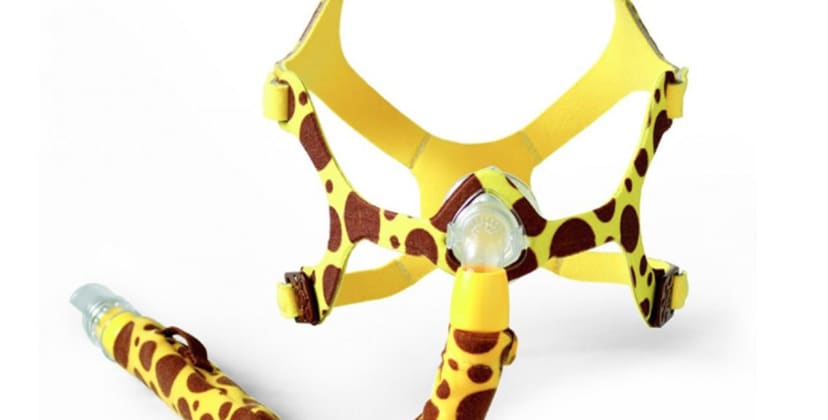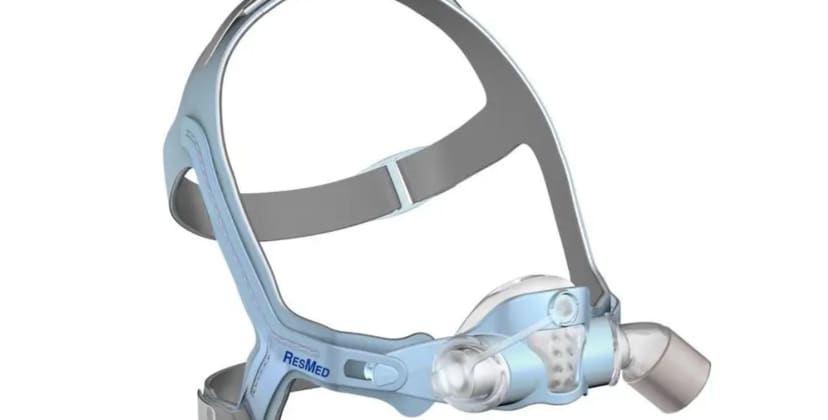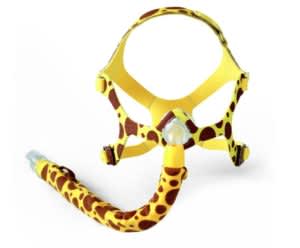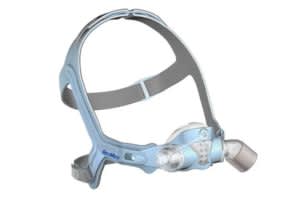When you buy through our links, we may earn a commission. Products or services may be offered by an affiliated entity. Learn more.
Best CPAP Masks for Children
Reliable Picks for Sleep Apnea Treatment
Medical Disclaimer: The content on this page should not be taken as medical advice or used as a recommendation for any specific treatment or medication. Always consult your doctor before taking a new medication or changing your current treatment.
Continuous positive airway pressure therapy is a common treatment for obstructive sleep apnea. CPAP therapy keeps the upper airway open during sleep by blowing pressurized air into a mask that fits over the nose, or the nose and mouth. The mask is an important part of CPAP therapy, as a well-fitting mask is more comfortable and helps ensure the air is delivered properly.
CPAP masks for children are made with smaller frames designed to fit smaller faces, and they come in a variety of styles to meet different needs. While your pediatrician can guide you to the type of mask that’s best for your child, it’s also helpful to have an understanding of the available mask designs and the benefits and disadvantages of each.
We’ll explore the best CPAP masks for children and discuss some factors to consider when shopping. We’ll also share advice on how to ease your child into CPAP therapy.
What’s the Best CPAP Mask for Children?
The Wisp Pediatric Nasal CPAP Mask comes in three child-friendly sizes and features a leak correction dial so you can adjust the mask without taking it off. The headgear loops around the ears, leaving a clear line of sight that may benefit kids who experience feelings of claustrophobia.
The Best CPAP Masks for Children
In-Depth Reviews
Best Overall
Philips Respironics Wisp Pediatric Nasal CPAP Mask
Use this link for the most current Philips Respironics discount
Shop Now
Some children don’t like wearing CPAP masks for extended periods of time, but the Wisp Pediatric Nasal CPAP Mask is designed for maximum comfort to make it easier on kids. The whimsical pattern may also appeal to children, especially younger ages.
-
Pros
-
Fun giraffe-patterned headgear with accompanying YouTube series
-
Leak correction dial lets you adjust the fit without removing the mask
-
Three sizes, covering infants to school-aged children
-
-
Cons
-
Only available in one pattern
-
Nasal design may be ineffective for children with blocked nasal passages
-
Contains magnets that may interfere with nearby implanted medical devices
-
Price
$148
The Wisp Pediatric Nasal CPAP Mask from Philips Respironics is a lightweight mask designed to comfortably fit small faces. This model stands out from other pediatric CPAP masks with its fun and whimsical giraffe pattern.
What Does It Do?
The mask has a low profile and does not require a forehead attachment, making it less obtrusive during play and bedtime routines. The mask includes three nasal cushions in different sizes, so that you can pick the cushion that is most appropriate for your child’s face. A leak correction dial allows you to adjust the mask to reduce excessive leakage of air. To clean the mask, simply hand wash in warm water with dishwashing liquid.
Who It’s Best For
The silicone material is soft and comfortable, allowing children to wear the mask for long periods without it causing discomfort or indenting the skin. The unobtrusive design also makes this mask a good choice for children who wear glasses. The mask is easy to put on, remove, and adjust, so most children should have no problem performing these tasks on their own.
CPAP mask purchases made through The CPAP Shop include a 30-day trial, which allows customers to return the mask for a full refund minus original and return shipping fees.
Note: According to the manufacturer, this mask is temporarily being produced without the brown giraffe spots due to a supply chain issue. Depending on the retailer and their current inventory, the mask may come in plain yellow.
Best Value
ResMed Pixi Pediatric CPAP Mask
Use this link for the most current ResMed discount
Shop Now
The Pixi Pediatric CPAP Mask prioritizes comfort and flexibility in its design. These features go a long way toward making kids comfortable, which can be a tall order when it comes to full-face CPAP masks.
-
Pros
-
Quick-release latch eliminates the need to adjust the headgear every time
-
Tubing can attach on the left or right side for side and stomach sleeping
-
Low-profile nasal mask design leaves a clear field of vision
-
-
Cons
-
May not be appropriate for children who have trouble breathing through their nose
-
One size only, designed for children from 2 to 7 years old
-
No kid-friendly patterns offered
-
Price
$137
Finding a comfortable and affordable CPAP mask for your child can be a struggle, especially if they need to wear a full-face mask. The Pixi Pediatric CPAP Mask from ResMed checks off a lot of boxes when it comes to full-face masks for kids.
What Does It Do?
A single-wall silicone cushion supports the chin and prevents air leakage without creating uncomfortable pressure on the child’s face, while the breathable straps are flexible enough to adapt to their facial structure. At the base of the mask, a quick-release latch allows you to easily disconnect the mask without interfering with the headgear’s settings. An additional emergency latch lets you release the latch even faster.
Who It’s Best For
The mask is equipped with two ports to attach the connective tubing, enabling your child to sleep on their side or back without interfering with the CPAP therapy. The flexibility of the tubing helps prevent it from getting snagged or caught, which is a helpful feature if your child changes sleep positions a lot during the night. Despite the Pixi’s various comfort and safety features, the mask carries a fairly low price-point compared to other full-face models with headgear, so shoppers on a budget may prefer this model.
Veterans and first responders receive a discount when ordering their mask through The CPAP Shop. All customers who purchase through this site qualify for a 30-day trial period.
What Is the Best Type of CPAP Mask for Children?
While there are exceptions, the best type of mask for most children is a nasal mask that leaves the mouth free. Being able to breathe through the mouth is especially important for young children or those who are unable to remove the mask by themselves.
| Mask Type | Description |
|---|---|
| Nasal CPAP Mask | Most nasal CPAP masks fit over the nose, offering a comfortable way to deliver airflow. This minimalist design may feel less claustrophobic than a full-face model. Nasal cradle masks seal around the bottom of the nose and have an even smaller footprint. |
| Nasal Pillow CPAP Mask | Though even more pared down than nasal cradle designs, nasal pillow CPAP masks fit into the nostrils, delivering direct airflow that some children may find uncomfortable. |
| Full-Face CPAP Mask | Full-face CPAP masks cover the mouth and nose. While convenient for children who have difficulty breathing through their nose, full-face masks are generally considered a secondary option. Total face masks cover the entire face and are sometimes used for younger children. |
| Hybrid CPAP Mask | A hybrid CPAP mask blends the concepts of a full-face mask and a nasal pillow or nasal cradle mask, delivering air to both the nose and mouth through an interface that makes minimal contact with the face. |
How to Choose the Right Mask
When shopping for CPAP masks, it’s helpful to know about the different designs and features that are available with different models. Children do not have as many mask options as adults, but pediatric masks do share similar designs with adult masks. In the video below, we explore different types of masks to help you decide on an ideal mask for your child.
1What’s Important to Consider in a Pediatric CPAP Mask?
When choosing your child’s CPAP mask, you should consider not only their therapy needs but also how well they tolerate the mask. Factors like comfort, fit, field of vision, and the ability for caregivers to adjust the mask may be especially important.
Doctor’s Recommendations
Your child’s pediatrician or sleep doctor is in the best position to decide if CPAP therapy is the appropriate treatment, and they can help you choose a CPAP mask based on your child’s needs. Families can perform the initial mask fitting and pressure testing in the doctor’s office, where the health care team can troubleshoot problems before starting CPAP therapy at home.
Sleeping Position
CPAP masks usually work best for back sleepers, as the tubing is less likely to catch on the bed pillow in this sleeping position. If your child is a side or stomach sleeper, or if they tend to move a lot during the night, a mask with top-of-head tubing might be more likely to stay in place.
Fit, Size, and Adjustability
A properly fitted CPAP mask should form an effective seal where it meets the face. Pediatric CPAP masks often have cushions adapted for a child’s facial profile, and the manufacturer may list the age range they’re designed for.
Most masks come with headgear straps that can be adjusted as needed, which is especially helpful for growing children. Manufacturers may also include design features so adults can easily adjust their child’s mask, or transparent components that allow adults to see if the mask is properly fitted.
Headgear and Accessories
Patterned headgear and other child-friendly accessories like matching stuffed animals, books, or videos may help your child be more accepting of their CPAP therapy.
Machine Compatibility
Most CPAP masks, even children’s masks, are compatible with the majority of CPAP machines. However, it’s a good idea to check the support documents before buying, as some travel CPAP machines may be incompatible with certain masks.
Recalls and Warranties
A mask warranty protects you for a limited period of time against manufacturing flaws, with most companies pledging to return your money or replace the mask if you find a problem. Certain replaceable parts, such as the mask cushion, may have shorter warranties.
A recall occurs when the mask’s design is inherently flawed and presents a safety issue for users. During a recall, you may need to provide your information to the manufacturer or supplier so they can exchange your mask for a different model.
Where to Buy a CPAP Mask for Children
CPAP masks are sold in stores and online, with many online retailers offering competitive prices and a wide selection. Alternatively, pediatricians or sleep clinics may supply masks and help you adjust them and learn to use them with your child.
Pricing, Prescriptions, and Insurance Coverage
Pediatric CPAP masks can cost anywhere from $50 to $200, with prices varying depending on the design, materials, and brand. Medicare, Medicaid, and many private insurers help cover the cost of CPAP equipment as long as your child meets certain usage requirements. Coverage under the Children’s Health Insurance Program (CHIP) depends on the state.
Masks require a prescription for purchase, although replacement parts are sold over the counter.
Tips for Helping Your Child Adjust to Sleeping With a CPAP Mask
Your child may not want to wear the CPAP mask at first, but you can help them become used to the idea with gentle persistence and help from your pediatrician. Your health care team can help navigate CPAP therapy in an age-appropriate fashion and provide additional strategies for children with anxiety or other disorders.
Ease Into CPAP Therapy
The success of CPAP therapy for children is heavily dependent on the caregiver’s actions. There are many strategies you can use to encourage consistent use of the CPAP mask and device:
- Work in small steps: Instead of starting CPAP therapy all at once, try letting your child wear the mask during the day for brief periods of time. Only when they are comfortable, proceed to turning on the air pressure without connecting the mask, and finally connect the mask and proceed with full CPAP therapy.
- Take a CPAP nap: It may feel less intimidating to start CPAP therapy during a short nap instead of a full night.
- Give rewards: Using rewards for good behavior is preferable to punishing bad behavior. Consider praising your child or giving them a small prize when they wear their CPAP mask.
- Use distraction: Encourage positive associations with CPAP therapy by allowing your child to play a game, read a book, or watch a movie with the mask on. Distraction is also a good tool if your child tries to take off the CPAP mask.
- Use media: Reading books or watching instructional videos that feature other children can help your child adjust to the idea of CPAP therapy.
Regularly Maintain the Mask
To keep therapy effective and hygienic, CPAP masks need to be cleaned regularly and the parts need occasional replacement per the user guide. CPAP mask cleaning generally involves a daily wipedown of the cushion, as well as a deep cleaning of the cushion, headgear, mask frame, and tubing attachment once a week.
Create a Cozy Sleep Space
You can help your child wind down for bed by dimming the lights, lowering noise levels, and keeping the bedroom at a comfortably cool temperature. Kids do well with a bedtime routine that helps them mentally prepare for sleep, so consider incorporating CPAP therapy into this routine.
Dive Deeper: In-Depth CPAP Guides
A mask is an essential component of CPAP therapy, but successful treatment also hinges on using an appropriate CPAP machine. While most devices come with a basic length of tubing, you may find that another type of CPAP hose is a better fit for your child’s needs.
We’ve also curated several guides to CPAP accessories. While not essential, you may find that they aid in the comfort or convenience of your child’s CPAP treatment.
Best CPAP Accessories by Type
Frequently Asked Questions
Is CPAP safe for kids?
CPAP therapy is considered a safe treatment option for children with obstructive sleep apnea when administered under the direction of a doctor with expertise in pediatric OSA. Nasal masks with transparent designs are generally considered safer for children than full-face masks. CPAP treatment may not be safe for children with certain conditions, such as trouble swallowing, recent or current collapsed lung, or problems with carbon dioxide management.
How often should you replace your child’s CPAP mask?
Mask suppliers and manufacturers generally provide replacement guidelines, as the time frame can vary depending on the mask and the specific part. As an example, you may need to replace the cushion every month, the frame every three months, and the headgear twice a year.
How should a pediatric CPAP mask fit?
To prevent leaks, the mask should fit snugly without being too tight. Most nasal masks extend from the bridge of the nose down between the nose and lips, without covering the mouth. You can use the headgear straps to adjust the mask and secure it in place, but be careful not to overtighten the mask, as this can cause uncomfortable pressure and may affect your child’s facial development.
What is the most comfortable CPAP mask for kids?
The most comfortable CPAP mask depends on the child’s individual profile. Doctors usually prescribe a nasal mask to children as a first-line treatment, as this style allows them to talk and cough with the mask on. Children who are unable to breathe through their nose or those with certain facial structures may need to use a full-face mask.
How do you prevent leaks with a pediatric CPAP mask?
The best way to prevent air leaks is by choosing a mask that fits well and adjusting it to the shape of your child’s face. It’s important not to overtighten the mask, as this can interfere with the shape of the seal and cause leaks.
Can kids grow out of sleep apnea?
While some children experience mild sleep apnea when they are young and eventually grow out of it, it’s important to treat sleep apnea in childhood to avoid the risk of long-term growth and development problems.
In addition to CPAP therapy, treatment methods include surgery to correct overly large tonsils or adenoids. Orthodontists or dentists who specialize in sleep apnea management may also recommend orthodontic techniques or oral appliances to widen the breathing passages. Lifestyle remedies like avoiding tobacco smoke and elevating the head of the bed may also help.

Still have questions?
Our product experts have extensive experience testing just about every sleep product on the market.
Send an email to [email protected] with your questions and we’ll help you find exactly what you’re looking for.


